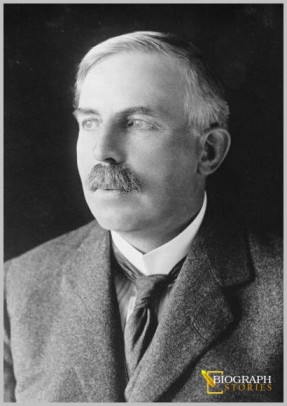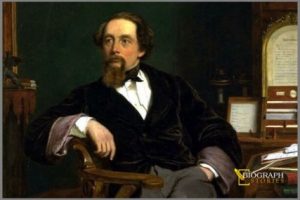
Ernest Rutherford Quick Facts:
Born: 30 August 1871, Brightwater, Colony of New Zealand
Died: 19 October 1937 (aged 66), Cambridge, England
Citizenship: British subject
Nationality: New Zealander
Residence: New Zealand, United Kingdom
Alma mater: Canterbury College, University of New Zealand, University of Cambridge
Known for: Discovery of alpha and beta radioactivity, Discovery of atomic nucleus (Rutherford model), Rutherford scattering, Rutherford backscattering spectroscopy, Discovery of proton, Rutherford (unit), Coining the term ‘artificial disintegration’
Awards: Rumford Medal (1904), Nobel Prize in Chemistry (1908), Barnard Medal (1910), Elliott Cresson Medal (1910), Foreign Associate of the National Academy of Sciences (1911), Matteucci Medal (1913), Copley Medal (1922), Franklin Medal (1924), Albert Medal (1928), Faraday Medal (1930), Wilhelm Exner Medal (1936), Faraday Lectureship Prize (1936)
Scientific career
Fields: Physics and chemistry
Institutions: McGill University, University of Manchester, University of Cambridge
Academic advisors: Alexander Bickerton, J. J. Thomson
Influenced: Henry Moseley, Hans Geiger, Albert Beaumont Wood
President of the Royal Society
In office: 1925–1930
Preceded by: Sir Charles Scott Sherrington
Succeeded by: Sir Frederick Gowland Hopkins
Biography of Ernest Rutherford:
New Zealand physicist Ernest Rutherford popularly known as the father of nuclear physics. In 1908, “for his investigations into the disintegration of the elements, and the chemistry of radioactive substances” he received the Nobel Prize in Chemistry. Radioactivity involved the nuclear transformation of one chemical element to another was established by him. In addition, he identified and named the Alpha and Beta radiations as well as named the Gamma rays. He theorized that atoms have their charge concentrated in a very small nucleus and that was time when the Rutherford model of the atom was introduced. In 1917, he conducted experiments that resulted in the first ‘splitting’ of the atom. He discovered and named the proton during the process.
His associate James Chadwick proved his theorization of neutrons under his supervision as the Director of the Cavendish Laboratory at the University of Cambridge. Soon after that, his students, John Cockcroft and Ernest Walton conducted the first experiment to split the nucleus in a fully controlled manner. In 1925, he was admitted to the Order of Merit. He was raised to the peerage as Lord Rutherford of Nelson in 1931. The chemical element 104 – Rutherfordium has been named after him.
Childhood & Early Life of Ernest Rutherford:
On 30 August 1871, Ernest Rutherford was born at Spring Grove, New Zealand. He was born to James Rutherford and Martha Thompson. His father was a Scottish emigrant farmer and hsis mother was an English emigrant schoolteacher. He was the second son and the fourth of a dozen children of this couple. Initially, he studied at Havelock School. He entered Nelson Collegiate School at the age of 16. Later, he won a University scholarship in 1889, and joined Canterbury College, University of New Zealand, Wellington. He was a bright student since childhood.
He was also interested in debates and rugby. In Mathematics and Physical Science, he received a double first M.A. degree in 1893. Before receiving his B.Sc. degree in 1894 he carried on his research work at the college for a brief period. In 1894, from the ‘Royal Commission for the Exhibition of 1851’ he received an ‘1851 Research Fellowship’ and as a research scholar under J.J. Thomson this helped him to pursue post-graduate studies at the Cavendish Laboratory, University of Cambridge.
Career of Ernest Rutherford:
Ernest Rutherford invented a detector for electromagnetic waves at Cambridge under the supervision of J. J. Thomson. At that point of time he managed to detect radio waves at half a mile. It was a groundbreaking achievement. He received his B.A. Research Degree in 1897 and the Coutts-Trotter Studentship of Trinity College. The presence of alpha and beta rays in uranium radiation stated by him in 1898. He also specified some of their characteristics.
He was accepted for the position of Macdonald Professor of Physics at McGill University in Montreal, Canada on Thomson’s reference in the same year. Two years later in 1900, he received a D.Sc. degree from the University of New Zealand. To become the Lang worthy Professor of Physics at the University of Manchester he returned to England in 1907. He worked on a classified project of submarine detection by sonar during World War I. Ernest Rutherford conducted the Geiger–Marsden experiment along with Hans Geiger and Ernest Marsden in 1909 that established the nuclear nature of atoms by deflecting alpha particles passing through a thin gold foil. As the Cavendish Professor of Physics, he succeeded Sir Joseph Thomson at Cambridge in 1919.
Eventually he became Chairman of the Advisory Council, H.M. Government, Department of Scientific and Industrial Research; Professor of Natural Philosophy, Royal Institution, London; and Director of the Royal Society Mond Laboratory, Cambridge. He also became the first person to transform one element into another in 1919. He used alpha radiation in the experiment to convert nitrogen into oxygen. In the products of the reaction, he observed and brought forth a new particle called proton in 1920. During the Bakerian Lecture of 1920, he also named the particle neutron. He theorized its existence in association with Niels Bohr in the following year.
In 1932, his associate James Chadwick, who received the Nobel Prize in Physics (1935) for this breakthrough, proved the theory right. To support education and research he urged the Government of New Zealand in 1925. The formation of the Department of Scientific and Industrial Research (DSIR) in 1926 was the result. He was the President of the Royal Society between 1925 and 1930. Later, he became the President of the Academic Assistance Council that assisted nearly 1,000 university refugees from Germany.
Personal Life & Legacy of Ernest Rutherford:
Ernest Rutherford married Mary Georgina Newton, only daughter of Arthur and Mary de Renzy Newton in 1900. The couple were blessed with a daughter, Eileen Mary and she was married to Ralph Fowler, British physicist and astronomer. Golf and motoring were Rutherford’s favorite hobbies. On 19 October 1937, after suffering from strangulated hernia he died at the age of 66. He was interred at Westminster Abbey, near Isaac Newton and Lord Kelvin.








